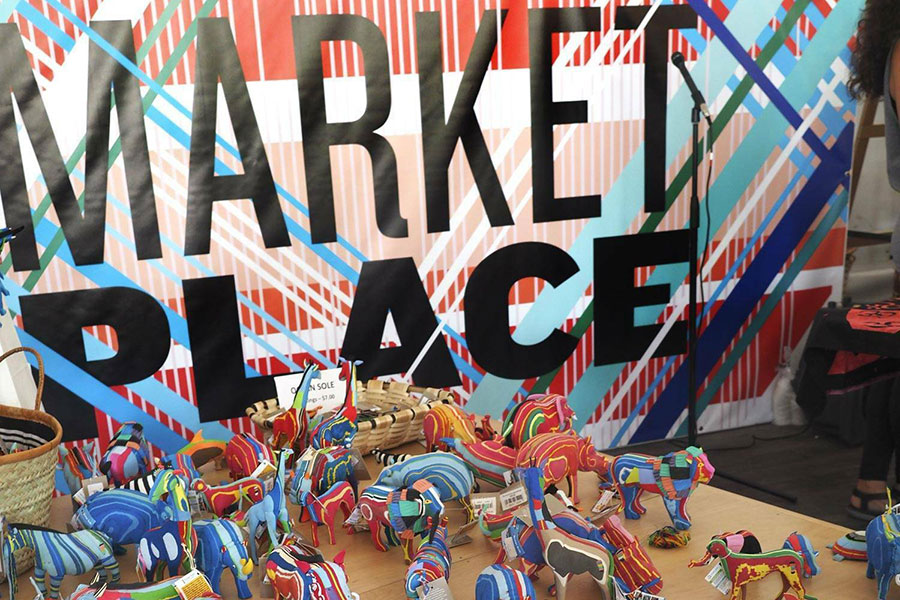-
Home
- Home Araujo Family
- Araujo Family

Araujo Family
"Metalwork art is my passion ? it is my life. All my life, I've practiced this beautiful art. For this reason, I consider myself one of the greatest promoters of artistic metalwork, as well as one of the last people to work in polychrome. <br><br>
"I'm Teofilo Araujo Choque. I was born in 1941 in Vilcanchos, located in Ayacucho. I lived in the country with my parents, who worked as farmers and kept livestock. <br><br>
"I became interested in metalwork at the young age of 12, when an accident crippled me. I fell into a pit and a sharp object cut my knee. In those days, there were no clinics in my community, and they could only heal me with herbs. I could no longer bend my knee, and my right knee has remained immobilized for my whole life. My family and I lived in the country. But with my injured knee, I couldn't walk. <br><br>
"Back then, broken tools and utensils were repaired, not thrown away like they are today. So any jar, pot, milk can, or pitcher that broke could be repaired. Merchants and tradesmen would go from house to house, repairing things. During one of these visits, I observed how they fixed things. I was curious and wanted to do this, because my injured leg kept me from working in the fields or herding livestock. <br><br>
"One day, my uncle Tomas Choque brought me to his house to take care of it. It happened that he had also learned to repair things by observing these workmen from out of town. <br><br>
"When he needed something, my uncle would go to the city of Huamanga to get pliers, scissors, and other things that he used to repair porcelain, tin, and zinc alloys. I found it fascinating and asked him to teach me. I asked him to bring me the basic tools, even though I didn't know what they were. This is how I began doing the same work my uncle did. I mimicked him when he sealed the bases of porcelain jugs, and I learned how to mend holes in ceramic jars and pots. <br><br>
"One day, the chapel authorities came to request a cross. They told me, 'Young man, you are an amateur and there are no metal workshops here. Can you make us a cross to put in the church?' I accepted, and I did the work without even knowing how to weld. It was crafted completely by hand, and I made it with recycled tin alcohol containers. The authorities were happy with the cross, and this is how I became excited about this art. <br><br>
"My uncle was the person who first taught me, and then I continued learning on the job when I moved to Huamanga, because it was there that I could find all my materials and tools. Huamanga gave me the opportunity to perform a service for the community, and I felt good when my clients were happy and thanked me for the crosses that I made. I loved it even more when my neighbors began making requests for crosses to put in their own homes. <br><br>
"I had to be patient, curious, observant, tenacious, and persistent in everything I did. I always thought that, if I could make any piece or design, I would not be limited by my disability. I was helped greatly by talking with others, and also by training sessions, forums, congresses, fairs, and interacting with people. <br><br>
"When I made the decision to do this work on my own, I determined I would succeed, no matter the cost. So I persevered under any condition. When I started my workshop in 1974, all of my tools were stolen, leaving me with nothing. Later, in 1983, I was robbed again! I experienced two robberies, but I made it through, thanks to the advice of good people who have crossed my path. <br><br>
"I remember Dario Gomez, a friend who was present during one of the robberies and reported it to the police. Dario gave me good advice and told me, 'Teofilo, you are young. Don't be sad or go on pushing yourself to make decisions. Don't go looking for another job, either. Instead, start over with what you have, and borrow or rent tools from your friends in order to continue.' These words were the strength I needed to carry on. I found it so profound that I worked very hard in order to get ahead and achieve my goals. <br><br>
"I encountered more difficulties in the 1990s due to the arrival of industrial plastics and aluminum from China. People didn't buy my designs because plastic and aluminum were cheap. I was on the verge of losing everything but I survived by adapting to the needs of my clients and reinventing my own line of work .<br><br>
"My creative and innovative strengths helped me a lot. People who admired my art promoted me and I began receiving awards and recognition. In 2009, the Cultural Ministry distinguished me as a Meritorious Person of Peruvian Culture and, after that, the Provincial Municipality of Huamanga named me Ambassador of Popular Art and Peruvian Handicrafts. Also, the Minister of MINCETUR (Ministry of Foreign Commerce and Tourism), Magali Silva, recognized me as a Promoter of Peruvian Handicrafts. I feel very proud to represent my country in this way, doing what I love most. <br><br>
"Today, my designs include candelabras, crucifixes, roosters, and sailboats, among other things. I especially enjoy making crosses and candelabras, And my most challenging work is making brass sculptures. My inspiration comes from the environment that I have lived in from my youth. In nature, I find all of the decoration that I use in my pieces, like the different varieties of flowers, birds, figures, shapes and forms. <br><br>
"Every morning, I wake up at 5:30 and go to my workshop to make my candelabras and my crosses. I live there ? it is my life and my home where I create new designs, paint and weld. My hope is that this art will continue over time, and that all of my sons, daughters, nieces, nephews, and everyone else who wants to learn will expand this local art. In that way, they will develop our society and ensure that new generations can learn to appreciate our culture and our arts, which is sorely needed. <br><br>
"My home workshop is open to the community. I teach metalworking to students from universities, institutions and high schools. We receive internships from different private educational institutions, and I lend artistic pieces to the institutions during their anniversary expositions. Through these activities, we spread and promote Peru's traditional artistic metalwork. <br><br>
"I have seven children. They all watched as I developed my art and saw the challenges along the way. They remember the dark and painful times in the 1980s, when they lost their homes and had to move elsewhere to find security and protect their families. <br><br>
"Lucy and Jang, stand out because they accompanied me from the beginning. They helped us by taking care of their younger brothers and sisters, and also went with me to find materials. They learned to use my tools, to paint and weld. Today, their work is excellent, as good as my own.
"So, what began as a hobby has become a lifestyle that both of them have committed to continuing, and to promoting in Peru and around the world ? their legacy. They are my greatest inspiration. <br><br>
"I'm very happy to work with you and have many dreams of sharing my art with the world. I hope people get to know me and enjoy my traditional works of art." <br><br>
Lucy and Jang continue studying and working hard to create a future that includes a shelter for abandoned children where they can share their art and enjoy life in the country. <br><br>
The Covid 19 pandemic has been very tough for <i>don</i> Teofilo, who had problems with his health. His family decided not to take him to the hospital where he might catch the Coronavirus. Many people who were admitted to the hospital passed away, so the family took care of him at home with the help of natural medicines and the guidance of some doctors from the capital. Today he is doing well and is at home with his family. <br><br>
Jang and Lucy continue to move ahead with their art. Lucy has a young child who is already learning the art by playing with recycled pieces, just as she began. They love what they do and want to share their legacy, traditions and customs with the world.


